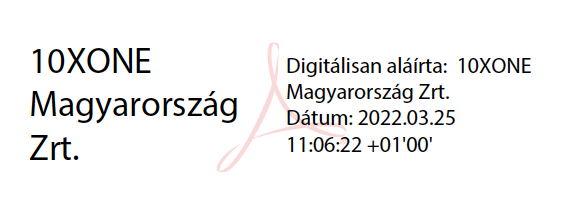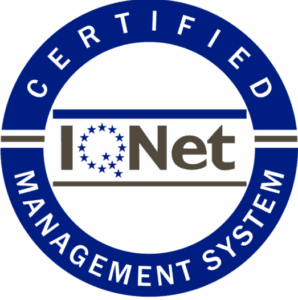ELECTRONIC SIGNATURE – AND WHAT DOES 10XONE PROVIDE?
Note: the reference to the Regulation and further information available on the central website of the European Union are summarized at the end of this article.
ELECTRONIC SIGNATURE: IN 1 SENTENCE
Electronic signature in 10xONE system complies with the current EU and Hungarian legislation.
And: since it is a qualified electronic signature, it has the same legal effect as if the document was signed by hand.
The relevant EU-level regulation has been in place since 1 July 2016 and is valid uniformly in all EU Member States, without the need for any additional local (national) regulation, law or legislation.
The other party may not refuse to accept an electronically signed document.
This is also ensured by the relevant binding EU regulation.
QUALIFIED ELECTRONIC SIGNATURE IN 10XONE – FOR WHAT CAN YOU USE IT?
There are multiple uses:
-contract signing
-proof of delivery signing
-CMR signing – trucking, forwarding
-HR and payroll documents signing
-invoice signing
QUALIFIED ELECTRONIC SIGNATURE: SAME AS SIGNATURE BY HAND – MORE INFO
The legal effects of electronic signatures in each EU Member State are set out in Article 25 of eIDAS.
The legal effect and acceptance as evidence of an electronic signature (simple, special or qualified) cannot be denied on the sole ground that it is in electronic form or that it does not meet the requirements for a qualified electronic signature.
Qualified electronic signatures, as provided by 10XONE, have the same legal effect as handwritten signatures in all EU Member States.

ELECTRONIC SIGNATURE: OK, BUT WHAT IS IT, FOR WHAT CAN IT BE USED AND HOW DOES IT WORK?
Electronic signature
An electronic signature is actually a series of numbers stored digitally that ensures that a pre-identified party (and only him or her / or a legal entity and not someone else) has signed the document.
The so-called key (this is actually the digital number sequence) is available from a so-called qualified trust service provider. This provider identifies that the person requesting the number sequence (the key) is a truly existing person or entity – and the one s/he states to be. This trust service provider then issues the signature, which is then stored in a secure location by the signer (similarly to e.g. a company stamp) and not accessible to anyone else.
Electronic timestamp
An electronic timestamp is also nothing but – we know, it may be boring to read the same – a series of digitally stored numbers. This, however, is not given “once” by the so-called qualified trust service provider, but each time you digitally sign a document. Think of it as a very precise (Swiss or atomic) digital clock.
The timestamp is sent by this service provider.
“Packing” a document: signature + timestamp – all into one
The document is sent by to the trust service provider that will sign the document and add the timestamp at the same time. At the same time, this very same trust service provider generates a unique identification number (so-called hash) for the entire content of the signed document. This hash is stored with the document, as well.
This ensures that anyone who accesses the contents of a digitally signed and timestamped document will not be able to produce the same very unique set of numbers – just another one, should the contents of the document be modified by any means after signing.
At any time this number (hash) can be easily calculated later – and if the newly generated number does not match the already stored hash you can immediately notice that the document has been modified.
10xONE: ELECTRONIC SIGNATURE + TIME STAMP: YES
Yes, you need an electronic signature AND a time stamp – and the time stamp must be received from an “official trusted authority” (who is a qualified trust service provider). The role of the timestamp is (also) to prove later that the document already existed with the given content at that time.
A combined qualified electronic signature and time stamp together means a qualified electronic signature that is 100% equivalent to a handwritten (handwritten) signature.

Yes – 10xONE does provide this.
10xONE: TRUST SERVICE PROVIDER CONNECTION: YES
Certified certificates and time-stamping services are provided by qualified trust service providers.
This should be thought of as a separate company (because they are) that deals specifically with the document that is being produced and stored, and provides both
-electronic signature
– and a timestamp
Of course, an IT system connection must be established with this service provider. 10xONE has already solved this, 100% integrated into our software, and it works 100% automatically. That is neither the user nor the user company needs to do this.
The list of qualified trust service providers is available on the European Union’s website:
https://esignature.ec.europa.eu/efda/tl-browser/#/screen/home
Yes – 10xONE uses a trust service provider that is on the list of officially accepted trust service providers.
DIGITAL OR ELECTRONIC SIGNATURE?
An electronic signature is data in an electronic format that the signatory uses to sign (Article 3.10 eIDAS).
Digital signature is a mathematical and cryptographic concept that is widely used to provide concrete and practical examples of electronic signatures (ETSI TR 119 100).
In practice they are the same.
ELECTRONIC SIGNATURE OR ELECTRONIC SEAL?
They are the same – the only difference is that in the case of a signature the signatory is a natural person, while in the case of a seal the signatory is a legal entity. There is virtually no difference.
LEGISLATION

Regulation (EU) No 910/2014 on electronic identification and trust services for electronic transactions in the internal market (better known as the eIDAS Regulation) has been directly applicable to EU Member States since 1 July 2016.
https://ec.europa.eu/digital-building-blocks/wikis/display/DIGITAL/eSignature
Why it is important that it is a regulation: this being a regulation, and not a directive, is what makes it directly applicable across the entire European Union without the need to be transposed into national law.
Main page of eIDAS (Electronic Identification and Trust Services) legislation:
https://digital-strategy.ec.europa.eu/en/policies/eidas-regulation
The full text can be accessed here:
https://eur-lex.europa.eu/legal-content/EN/TXT/?uri=uriserv:OJ.L_.2014.257.01.0073.01.ENG
RELATING FAQ PAGE OF THE EU
https://ec.europa.eu/digital-building-blocks/wikis/display/DIGITAL/eSignature+FAQ
GEOGRAPHICAL EFFECT OF THE LEGISLATION

Article 35 of Regulation (EU) N°910/2014
Legal effects of electronic seals
1. An electronic seal shall not be denied legal effect and admissibility as evidence in legal proceedings solely on the grounds that it is in an electronic form or that it does not meet the requirements for qualified electronic seals.
2. A qualified electronic seal shall enjoy the presumption of integrity of the data and of correctness of the origin of that data to which the qualified electronic seal is linked.
3. A qualified electronic seal based on a qualified certificate issued in one Member State shall be recognised as a qualified electronic seal in all other Member States.

